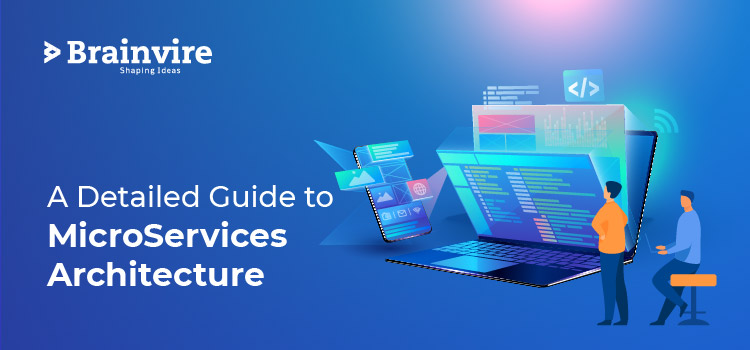
As digitization has reached its pinnacle, software applications have become more complex, bulkier, and difficult to maintain, update, and manage. Microservices architecture is a new add-on that addresses this issue by shredding complex software into autonomous building services. The modular services can be managed and deployed separately.
The term ‘Microservice’ dates back to 2005, Peter Rodgers the founder of Resource Oriented Computing came up with the word ‘Micro-web-services’. He provided the principle structure of a well-constructed microservice forum. With time, the updates made microservice architecture the future of software development.
But before you get in touch with an ASP.Net core development company for modern, cloud-based, IoT enabled web apps, let’s take an in-depth look at Microservice Architecture.
Microservices Architecture: What Is it?
There is no definitive definition of Microservices. So, it won’t be wrong to define Microservices Architecture as a framework to develop software applications. Traditional architecture aims to design the software like a single entity, but microservices architecture aims to build modular services that can be managed separately. In simple words, apps are designed as suites of various microservices that can be separately managed and deployed.
Microservices are designed to suit business potentials. Being broken into several services, they offer a lot of agility and flexibility regarding programming languages, software, and hardware.
Microservice Architecture has many features, one of which is the way the architectural mode splits up a complex app. The software breaks into multiple autonomous units that are deployed, updated, and managed singly. These services are processes that continually interact over a network using technology- agnostic policies.
How to Implement Microservice Architecture?
Microservices are segregated from one another entirely, and function in their designated setting. Autonomous apps interact with other services via specified interfaces. There are many ways to separate different services.
Containers
This is the easiest way to build microservice architecture. However, containers are not a robust method of virtualization as they do not compete with Virtual Machines. Rather, you design it on an existing OS. By using containers, microservices can run independently, everything that they need to function is in the container itself.
Virtual Machines
Virtual Machines can be created for each service and can operate independently in this area. Virtual machines need different operating systems for each service to function. This feature makes it a bit expensive as you will need a lot of resources to recoup the requirements. However, it is the strongest method of virtualization.
You can even go for a separate physical server for each service. In reality, it is said to be a waste of resources, so virtualization is used to make the process economical and fast. The key feature of microservices is isolation, so make sure you choose the right one. Make sure you don’t run various microservices in one container; this can lead to severe discords between the autonomous apps.
ASP.Net development company helps developers to construct modern-day applications with fewer complexities.
Pro tip: Use a load-balancer to manage and prevent overloading in the system. These automatically disseminate the stress among various models to deter failures.
Advantages of Microservices Architecture
If used properly for the right project, microservices can extend a wide range of benefits to the organization. Some advantages of using microservices are:
Converged Business Functionality
The usage of Microservices eradicates the requirement to design basic functionality that is used in the organization for multiple purposes. If you develop business services that assist various applications as Microservices, it will be easier for you to manage smaller units compared to complex apps.
Improved Resilience
Since the apps have various services functioning to serve the need, they communicate via defined interfaces. So, when one service isn’t available due to technical issues, another one substitutes to take over instantly. This improved fault-detection helps in retaining larger applications when a small unit fails to function.
Data Production Flexibility
As the data extraction process simplifies for multiple end-users, Microservices enables developers to design the data presentation easily.
Cross-Functional Board
Microservice architecture is designed to fulfill business priorities and potentials. These services take a broader implementation of software entailing continual storage, project management, external collaborations, and user experience. With external collaboration, they can deliver services interacting via interfaces, interpreting the team as cross-functional.
Easy Maintenance
This benefit is the most common one when using Microservices. The Microservice Architecture enables segregation of complex apps, making them easier to manage and deploy. Each service can be managed and operated by different teams, since every service stands for different processes.
Disadvantages of Microservices
Most drawbacks are related to those with implementing a new architecture or technology. However, discussing the disadvantages will provide you with adequate information before using Microservices.
- No definite definition of the scope, boundaries, and size of microservices
- Difficulty in managing the complex and rich business logic in business application
- A high-quality transmission of information is needed to make sure that an update of one service doesn’t harm the functionalities of others
- A large multitude of microservices is hard to secure
- Automation testing gets more complex when every microservice functions in a different environment
Microservices makes an operation complex so you will need an experienced operations team to manage it efficiently
Disparities Between Traditional and Microservice Architecture
Monolithic is the counterpart of Microservice Architecture. In the traditional approach, an app is designed as a single component as opposed to loosely bonded units. The Monolithic Architecture comprises a user interface, server-side app, and one database, making it a sole logical executable.
In simpler words, Monolithic Architecture works as a single unit. This means that one failure can impact the whole system, leading to functionalities issues. Whenever any alterations are made, development teams require to locate new versions of the server-side app.
On the other hand, the capabilities of Microservices are expressed with formal business-oriented APIs. The implementation of any service is hidden, since the system is completely defined in business terms. To be precise, if deployed in a proper way, architecture based on Microservices can add significant value to any business.
Conclusion
Apart from the above-mentioned benefits, there are many reasons why more companies are adopting a Microservice Architecture. Since complex applications are difficult to manage, Microservices can lead your enterprises to a self- sufficient approach, where every service works in a different environment and is used for different processes as well.
However, for expert solutions on the development of cloud-based apps, you can go for a leading ASP.NET Core development company.
Related Articles
-
Microsoft Edge: Boosting Productive Web Browsing Experience
Introduction In today’s fast-paced digital landscape, productivity is paramount. As we spend increasingly more time online, the need for a web browser that not only keeps up with our demands
-
Difference Between Power BI and MSBI
A clear understanding of MSBI and Power BI can help you enhance your overall BI journey. This improved knowledge also helps you to select reliable Power BI Consulting Services for
-
Predictive Analytics in Clinical Trials
Industry after industry has been completely transformed by data analytics, and the healthcare sector stands to benefit more than others. Predictive analytics in clinical trials is one of the most



